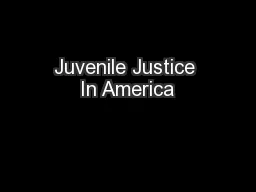

SOC 106 Part 10 Drug Use and Delinquency Frequently abused drugs a Marijuana hashish THC most commonly used illicit drug not physically addicting physical dangers ID: 715672
Download Presentation The PPT/PDF document "Juvenile Justice In America" is the property of its rightful owner. Permission is granted to download and print the materials on this web site for personal, non-commercial use only, and to display it on your personal computer provided you do not modify the materials and that you retain all copyright notices contained in the materials. By downloading content from our website, you accept the terms of this agreement.
Slide1
Juvenile Justice In America
SOC 106
Part 10
: Drug Use and DelinquencySlide2
Frequently abused drugs
a.
Marijuana / hashish
= THC
- most commonly used illicit drug
- not physically addicting
- physical dangers
- psychologically addicting
b.
Cocaine
- most powerful natural stimulant
- sniffed / snorted / injected = “rush”
- physical dangersSlide3
(1) Crack
- processed street cocaine
- ammonia / baking soda
- crystalline form = smoked
c.
Heroin
- narcotic drug
- most dangerous
- build tolerance
- sniffed / snorted / skin pop / mainlining
- user becomes addictedSlide4
d.
Alcohol
- drug of choice
- 56% have been drunk by 12
th
grade
- factor in nearly half of all murders / suicides /
accidental deaths
- “part of growing up”
e. Other drugs
- inhalants / tranquilizers / stimulants / steroids
/ hallucinogens / designer drugs / cigarettes
2. Drug use todaySlide5
- various studies
a.
Monitoring the Future
- survey of teen substance abuse
- continues to decline / become stable
b.
Parents’ Resource Institute for Drug Education
(PRIDE)
- little or no change
c.
National Survey on Drug Use and Health
- declined = still a problemSlide6
Why take drugs?
a.
Social disorganization
- poverty
- racial prejudice
- low-self esteem
(1) One study
- little if any association between social
class and drug use
(2) Drug use higher = urban classSlide7
b.
Peer pressure
- wanting to be accepted / fit in
- poor parental supervision
c.
Family factors
- unhappy childhood
- child abuse
- parental drug use
- divorce / separation
d.
Genetic factors
- alcohol parents = alcoholic childrenSlide8
e.
Emotional problems
- internalize / introverted
- blaming others
- personality disorders
f.
Problem behavior syndrome
- maladjusted / emotionally distressed
- many social problems
g.
Rational choice
- choose drugs to get high
Slide9
Pathways to drug abuse
a.
Gateway drug
- alcohol / marijuana
b.
Petty users
- sell small amounts / support their use
- do not consider seriously involved with drugs
c.
Frequently sell
- make money
- get their drugsSlide10
c.
Dealers who commit other crimes
- 2% teenage population = 40% of crimes
- most = gang bangers
d.
Losers / burnouts
- heavy drug use
- commit crimes to support habit
e.
Persistent offenders
- 2/3s continue into adulthood
- poor family / poor in school / use at early age
- few opportunitiesSlide11
5.
Drug use
- a large part of delinquency
- early users = chronic offenders
a.
Law enforcement efforts
- drug programs
- strict enforcement
b.
Education
- elementary through high school
- parents involvement
c.
Community involvementSlide12
- evening programs
- job programs
- feeling a part of
d.
Treatment strategies
- 150,000 per year = treatment
- marijuana
- look at problems = youth / family / peers
e.
Harm Reduction
- minimize harmful effects
- needle exchange / medical marijuana